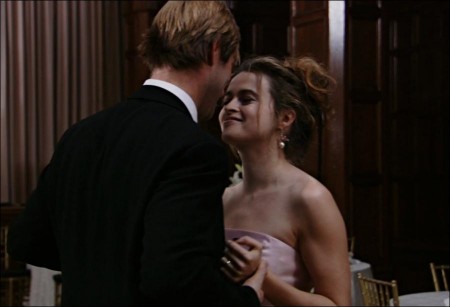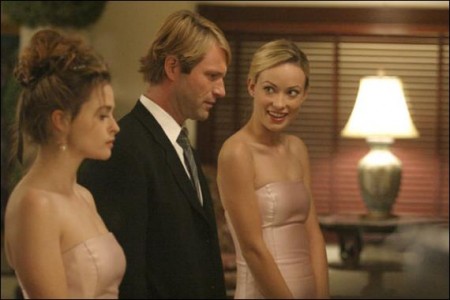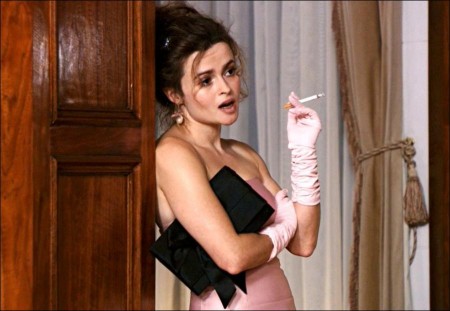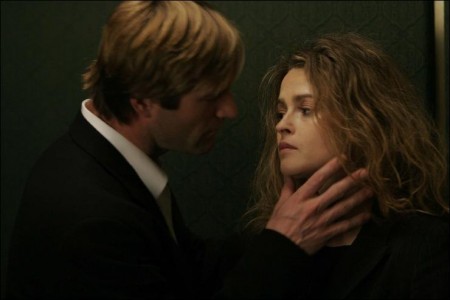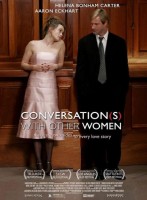When a man (Aaron Eckhart) and a woman (Helena Bonham Carter) flirt with each other at a wedding reception, the sexual tension seems spontaneous. As they break from the party to a hotel room, the flirtation turns into a night filled with passion.
“Conversations With Other Women” tells the compelling story of a couple whose reunion at a wedding reception ignites a mysterious attraction for each other that is deeper and more emotionally perilous than they are willing to admit.
At a New York City wedding reception two guests, seemingly strangers, become entangled in a sexually-charged battle of wits. But as the night carries on in a cigarette smoke haze, the nameless couple’s repartee deepens to reveal the passion of their two decades past love affair. Escaping the party for a hotel room, the two are soon gripped by their mutual past and the individual choices that lead them to the present.
The dramatic feature film “Conversations With Other Women” stars Academy Award and Golden Globe nominee Helena Bonham Carter (Tim Burton’s The Corpse Bride, Wallace & Gromit, The Wings of The Dove, Fight Club, Tim Burton’s Planet of The Apes, Charlie and The Chocolate Factory) and Independent Spirit Award winner Aaron Eckhart (Thank You For Smoking, Paycheck, Erin Brockovich).
About the Production
“Conversations With Other Women” was shot, and will be screened in “dual-frame,” a unique method that intimately tells this personal story. Director Hans Canosa developed this technique to more effectively convey the emotional journey of the two main characters simultaneously. Two cameras were used for every scene and take, resulting in an advanced split-screen effect in the theater.
The two camera system presented an unprecedented challenge to the actors during production. Unlike traditionally shot and cut films, the actors knew that all moments of a take could end up on screen, and thus ‘acted through’ every take. The acting adage ‘in the moment’ was constantly demanded of the actors as they created these beautiful and vulnerable characters. The resulting dual-frame film presents the actors’ work in the way musicians play in a duet, with action, dialogue and reaction running on both sides of the frame in real time. The movie represents two remarkable achievements in screen acting.
Director Hans Canosa says, “When shooting a single frame movie, film actors are often responsible for delivering only three to four seconds of performance for an edit. While shooting this film, the actors were often required to deliver three to four minutes of performance that would end up on screen without a cut. Performing at this extraordinary level required actors of enormous concentration and incredible craft. This challenge inspired Helena and Aaron to deliver outstanding performances of remarkable depth and complexity.”
The dual-frame format enhances the emotional impact allowing the audience to see actions and reactions in real time. It can provide for simultaneous flashbacks, can speed up and slow down time, and can reveal alternate emotional responses – all to service the overall narrative and contribute to a more complex and complete viewing experience.
Executive producer Kwesi Collisson managed the visual effects task on the film. Because of the dual-frame format, the 112 effects shots were far greater than the average love story or intimate drama.
Collisson said, “The most difficult shot was in the final scene. We needed to composite foreground elements of Helena and Aaron in a taxi with New York City background plates. The shot has different background plates on each side, and then the shots “merge” to form a single background. We even animated a digital still of a delivery truck and a cab behind the foreground element – and in front of the previous background shot.”
Collisson and Canosa did extensive research in pre-production to determine the best camera system, hardware and software solutions, and effects techniques. To fully explore the possibilities of dual-frame storytelling, they shot and edited dual-frame tests, shot a series of complimentary-angle digital stills with two actors to ensure that jump cuts would work visually in the dual-frame format, and storyboarded the entire film.
The dual-frame format allows the actors to express a range of emotions in different takes of the same moment. While on-set, Helena and Aaron coined the term `double-siders.’ This dual-frame storytelling technique allows the audience to experience opposing emotions from one character on both sides of the screen — like watching both the conscious and sub-conscious simultaneously.
In this unusual and sophisticated love story, seeing reactions to action and dialogue as they are occurring (instead of relying on cutting back and forth between two main characters) builds the emotional involvement for the moviegoer, creating a strikingly unique and rewarding film experience.
Canosa says, “Watching this film in dual-frame format will draw moviegoers into an unconventional love story, allowing them to share the intimate experience of the characters in a way that would not have been possible otherwise.” Fabrication Films president Glen Reynolds says, “One of our company’s primary objectives is to discover the work of innovative filmmakers. The terrific story, wonderful talent and distinctive dual-frame format of `Conversations With Other Women’ made this an ideal project for us to distribute.”
About the Title
The title reveals one of the essential themes of the film: the struggle to reconcile the past with the present. The Man (Aaron Eckhart) tries to rekindle his past relationship with the Woman (Helena Bonham Carter), and as they linger together at a wedding reception, he describes his memory of her 12 years ago. She replies, “I’m not interested in other women.” In other words, she is no longer that same woman who once loved him. New experiences and relationships turn us into different people over time, and we can’t expect those people to connect in the same way. This particular conversation between these two different people leads to an affair, if just for one night. Quite literally the Woman becomes “the other woman”
Why Split Screen?
Split screen experiments have been around almost since the beginning of movies. In 1913 Lois Weber made the short film Suspense employing a split screen. Abel Gance used what he called ‘the music of light’ to make Napoleon on three screens. More recent experiments include Mike Figgis’ Timecode and the television series ’24’. Since there are two sides to every love story, split screen proved to be the perfect way to tell both sides of Conversations with Other Women.The technique is traditionally used to show two scenes that are happening in different places at the same time (Pillow Talk is a classic example).
While we use split screen this way, it is most often used to show the different experiences of our two characters in the same scene at the same time. Seeing both characters act and react in real time lets the audience follow the emotional experience of the characters without interruption. They can choose how to watch the film and become a participant in the editing of the movie.In addition to providing two perspectives on the same scene, the two screens are a visual metaphor for two people who are apart and want to come together. Despite the fact that the two frames constantly keep the characters separate, the dual frame, much like the characters themselves, is continually trying to become one, and trying to bring them together.
The tendency of the two screens to try to merge provides the opportunity that filmmakers of love stories always seek: a special screen kiss, and later in the film, an opportunity for what is maybe the holy grail, a truly unique sex scene. The two frames can also be used to express a character’s thoughts, like how the woman imagines the man’s girlfriend when he tells her that his girlfriend is a professional dancer, or to show the woman imagining what her night would have been like if she’d not spent it with this man.All of the ways that the split screen can show overlapping time, whether that’s the present and memory, or the present with alternate presents, or the present and the future, make it possible to tell the story of this man and woman living an entire relationship in one night.
These production notes provided by Fabrication Films.
Conversations with Other Women
Starring: Aaron Eckhart, Helena Bonham Carter, Thomas Lennon, Brian Geraghty, Nora Zehetner, Olivia Wilde
Directed by: Hans Canosa
Screenplay by: Gabrielle Zevin
Release Date: August 11th, 2006
MPAA Rating: R for language and sexual content.
Studio: Fabrication Films
Box Office Totals
Domestic: $379,418 (39.3%)
Foreign: $584,818 (60.7%)
Total: $964,236 (Worldwide)

